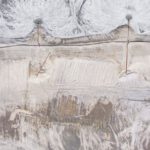Geckos are fascinating creatures that have the amazing ability to stick to walls and ceilings. Their feet are specially adapted for this purpose, allowing them to climb and cling to various surfaces. In this article, we will explore the science behind how gecko feet stick to walls.
The Science of Gecko Feet
Gecko feet are covered in millions of tiny hair-like structures called setae. These setae are so small that they are invisible to the naked eye. Each seta branches out into even smaller structures called spatulae, which are only a few micrometers in size.
The Van der Waals Force
The secret to gecko feet’s sticking power lies in a phenomenon called the Van der Waals force. This force is an intermolecular force that occurs when two surfaces are brought close together. The Van der Waals force is responsible for the attraction between the setae on gecko feet and the surfaces they come into contact with.
The Van der Waals force is a weak force, but because each gecko foot has millions of setae, the cumulative effect is incredibly strong. This allows geckos to support their entire body weight on a single foot while clinging to a vertical surface.
Spatulae: The Key to Adhesion
The spatulae on gecko feet play a crucial role in enhancing adhesion. These tiny structures increase the surface area of the setae, allowing for more contact points with the surface. The increased contact points result in a stronger Van der Waals force and improved adhesion.
The Importance of Surface Roughness
The surface roughness of the object geckos are climbing on also affects their ability to stick. Geckos are most efficient at clinging to surfaces that have a similar roughness to their setae. When the surface is too smooth, there is not enough contact area for the Van der Waals force to act upon. Conversely, if the surface is too rough, the setae cannot make sufficient contact with the surface.
Gecko Feet and Self-Cleaning
One remarkable feature of gecko feet is their self-cleaning ability. As geckos walk, their feet naturally shed any dirt or debris that may have accumulated. This is due to the structure of the setae, which are flexible and can easily release any particles trapped between them.
The Future of Gecko-Inspired Technology
Gecko feet have inspired scientists and engineers to develop new adhesive technologies. Mimicking the structure and properties of gecko feet, researchers have created synthetic adhesives that can adhere to various surfaces. These adhesives have the potential to revolutionize industries such as robotics, manufacturing, and healthcare.
One example of gecko-inspired technology is the development of climbing robots. These robots utilize adhesive materials that mimic the properties of gecko feet to climb walls and navigate vertical surfaces. This technology has the potential to revolutionize search and rescue operations, as well as inspection and maintenance tasks in hazardous environments.
Conclusion
Gecko feet are a marvel of nature, allowing these creatures to effortlessly navigate vertical surfaces. The setae and spatulae on gecko feet, along with the Van der Waals force, work in harmony to create an adhesive system that defies gravity. By studying and understanding the science behind gecko feet, scientists and engineers are developing new technologies that could have significant applications in various fields. The future of gecko-inspired technology is promising, and we can only imagine the possibilities that lie ahead.





